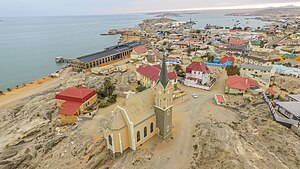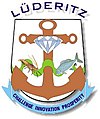Lüderitz
| Lüderitz | ||
|---|---|---|
| Town | ||

An aerial view of Lüderitz with the Felsenkirche in the foreground and the rest of the town in the background.
|
||
|
||
| Motto: Challenge, Innovation, Prosperity | ||
| Location in Namibia | ||
| Coordinates: 26°38′45″S 15°9′14″E / 26.64583°S 15.15389°ECoordinates: 26°38′45″S 15°9′14″E / 26.64583°S 15.15389°E | ||
| Country |
|
|
| Region | ǁKaras Region | |
| Constituency | ǃNamiǂNûs Constituency | |
| Established | 1883 | |
| Government | ||
| • Mayor | Hambelela Suzan Ndjaleka | |
| Population (2011) | ||
| • Total | 12,537 | |
| Climate | BWk | |
| Website | http://www.luderitz-tc.com | |
Lüderitz is a harbour town in the ǁKaras Region of southern Namibia, lying on one of the least hospitable coasts in Africa. It is a port developed around Robert Harbour and Shark Island.
The town is known for its colonial architecture, including some Art Nouveau work, and for wildlife including seals, penguins, flamingos and ostriches. It is also home to a museum, and lies at the end of a currently[update] decommissioned railway line to Keetmanshoop.
In 2013, it was announced that Lüderitz was renamed into ǃNamiǂNüs. This pertains only to the constituency, however.
The bay on which Lüderitz is situated was first known to Europeans when Bartolomeu Dias encountered it in 1487. He named the bay Angra Pequena (Portuguese: Small Bay) and erected a padrão (stone cross) on the southern peninsula. In the 18th century Dutch adventurers and scientists explored the area in search of minerals but did not have much success. Further exploration expeditions followed in the early 19th century during which the vast wildlife in the ocean was discovered. Profitable enterprises were set up, including whaling, seal hunting, fishing, and guano-harvesting. Lüderitz thus began its life as a trading post.
...
Wikipedia


